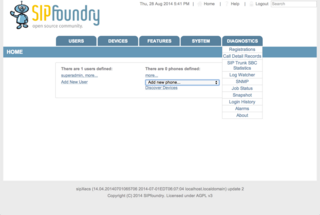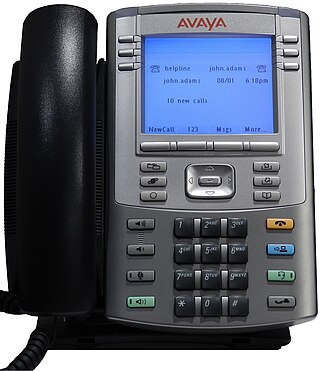The Session Initiation Protocol (SIP) is a signaling protocol used for initiating, maintaining, and terminating communication sessions that include voice, video and messaging applications. SIP is used in Internet telephony, in private IP telephone systems, as well as mobile phone calling over LTE (VoLTE).
Voice over Internet Protocol (VoIP), also called IP telephony, is a method and group of technologies for voice calls, the delivery of voice communication sessions over Internet Protocol (IP) networks, such as the Internet.
The Skinny Client Control Protocol (SCCP) is a proprietary network terminal control protocol originally developed by Selsius Systems, which was acquired by Cisco Systems in 1998.
Inter-Asterisk eXchange (IAX) is a communications protocol native to the Asterisk private branch exchange (PBX) software, and is supported by a few other softswitches, PBX systems, and softphones. It is used for transporting VoIP telephony sessions between servers and to terminal devices.
The IP Multimedia Subsystem or IP Multimedia Core Network Subsystem (IMS) is a standardised architectural framework for delivering IP multimedia services. Historically, mobile phones have provided voice call services over a circuit-switched-style network, rather than strictly over an IP packet-switched network. Alternative methods of delivering voice (VoIP) or other multimedia services have become available on smartphones, but they have not become standardized across the industry. IMS is an architectural framework that provides such standardization.
An Internet telephony service provider (ITSP) offers digital telecommunications services based on Voice over Internet Protocol (VoIP) that are provisioned via the Internet.

Skype for Business Server is real-time communications server software that provides the infrastructure for enterprise instant messaging, presence, VoIP, ad hoc and structured conferences and PSTN connectivity through a third-party gateway or SIP trunk. These features are available within an organization, between organizations and with external users on the public internet or standard phones.

A VoIP phone or IP phone uses voice over IP technologies for placing and transmitting telephone calls over an IP network, such as the Internet. This is in contrast to a standard phone which uses the traditional public switched telephone network (PSTN).

SipXecs is a free software enterprise communications system.

Nortel Meridian is a private branch exchange telephone switching system. It provides advanced voice features, data connectivity, LAN communications, computer telephony integration (CTI), and information services for communication applications ranging from 60 to 80,000 lines.
Text over IP is a means of providing a real-time text (RTT) service that operates over IP-based networks. It complements Voice over IP (VoIP) and Video over IP.

H.323 is a recommendation from the ITU Telecommunication Standardization Sector (ITU-T) that defines the protocols to provide audio-visual communication sessions on any packet network. The H.323 standard addresses call signaling and control, multimedia transport and control, and bandwidth control for point-to-point and multi-point conferences.

Snom Technology GmbH is a German company which manufactures Voice over Internet Protocol (VoIP) telephones, based on the IETF standard Session Initiation Protocol (SIP). Snom's products are targeted at the small- to medium-sized business sector, home offices, Internet service providers, carriers, and original equipment manufacturers. The company, founded in 1996 and headquartered in Berlin, is a wholly owned subsidiary of VTech Holdings Limited, since 2016.
Unified communications (UC) is a business and marketing concept describing the integration of enterprise communication services such as instant messaging (chat), presence information, voice, mobility features, audio, web & video conferencing, fixed-mobile convergence (FMC), desktop sharing, data sharing, call control and speech recognition with non-real-time communication services such as unified messaging. UC is not necessarily a single product, but a set of products that provides a consistent unified user interface and user experience across multiple devices and media types.

Avaya IP Phone 1140E in telecommunications is a desktop Internet Protocol client from 1100-series manufactured by Avaya for unified communications. The phone can operate on the Session Initiation Protocol (SIP) or UNIStim protocols. The SIP firmware supports presence selection and notification along with secure instant messaging. This device has an integrated 10/100/1000BASE-T auto-sensing Ethernet switch with two ports and an integrated USB port, and is Bluetooth capable. The SIP version of this phone has full IPv6 functionality and only requires 2.9 watts of power.
A softphone is a software program for making telephone calls over the Internet using a general purpose computer rather than dedicated hardware. The softphone can be installed on a piece of equipment such as a desktop, mobile device, or other computer and allows the user to place and receive calls without requiring an actual telephone set. Often, a softphone is designed to behave like a traditional telephone, sometimes appearing as an image of a handset, with a display panel and buttons with which the user can interact. A softphone is usually used with a headset connected to the sound card of the PC or with a USB phone.
SunComm Technology is a Taiwan multinational computer technology and GSM Voice over IP gateway manufacturer. The main products in 2010 focused on GSM VoIP gateways & IP surveillance camera devices. Core members have been engaging in the communication & networks industry since 1977.
The 1100-series IP phones are 6 different desktop IP clients manufactured by Avaya for Unified communications which can operate on the SIP or UNIStim protocols. The SIP Firmware supports presence selection and notification along with secure instant messaging.

The media gateway control protocol architecture is a methodology of providing telecommunication services using decomposed multimedia gateways for transmitting telephone calls between an Internet Protocol network and traditional analog facilities of the public switched telephone network (PSTN). The architecture was originally defined in RFC 2805 and has been used in several prominent voice over IP (VoIP) protocol implementations, such as the Media Gateway Control Protocol (MGCP) and Megaco (H.248), both successors to the obsolete Simple Gateway Control Protocol (SGCP).








